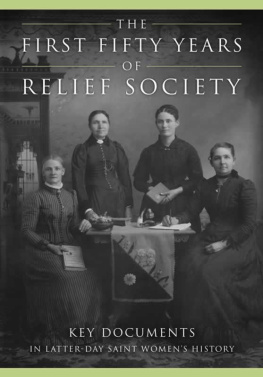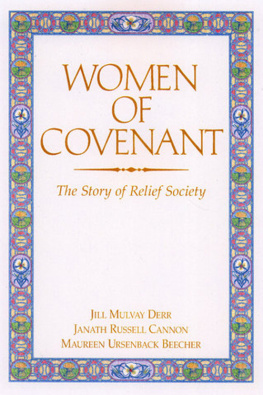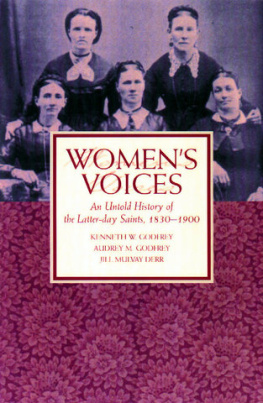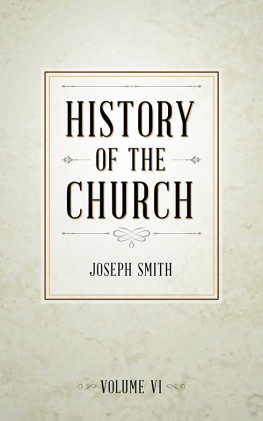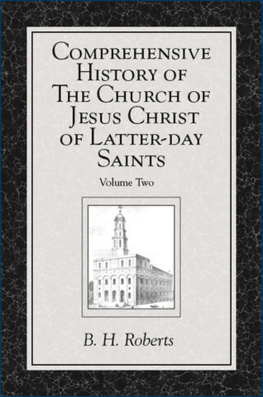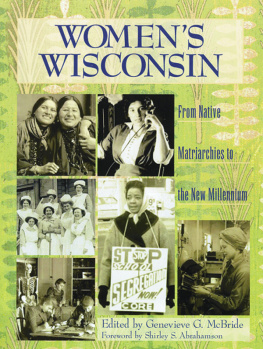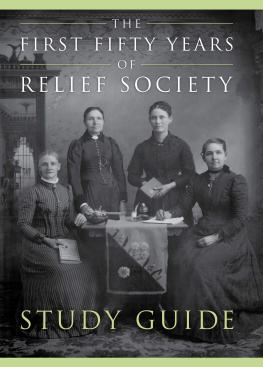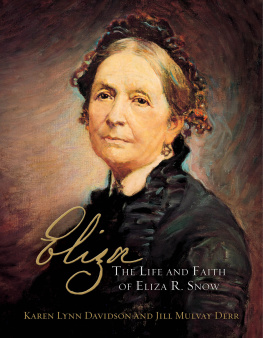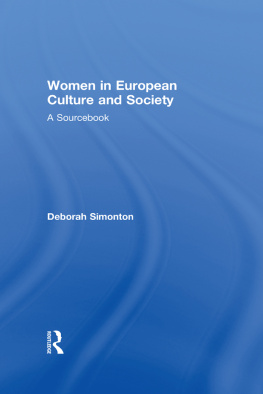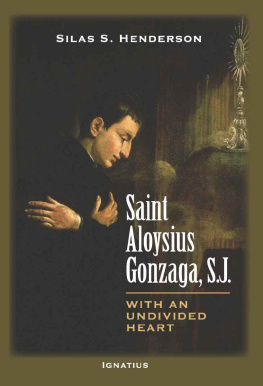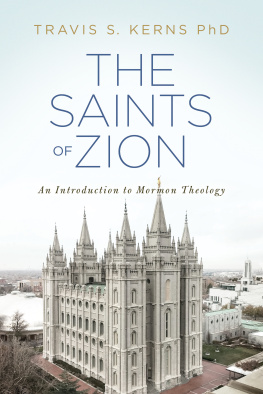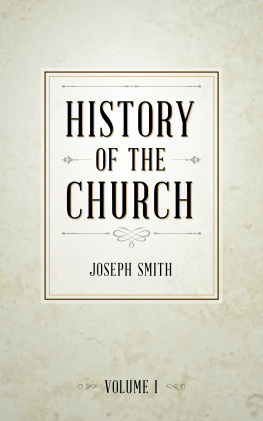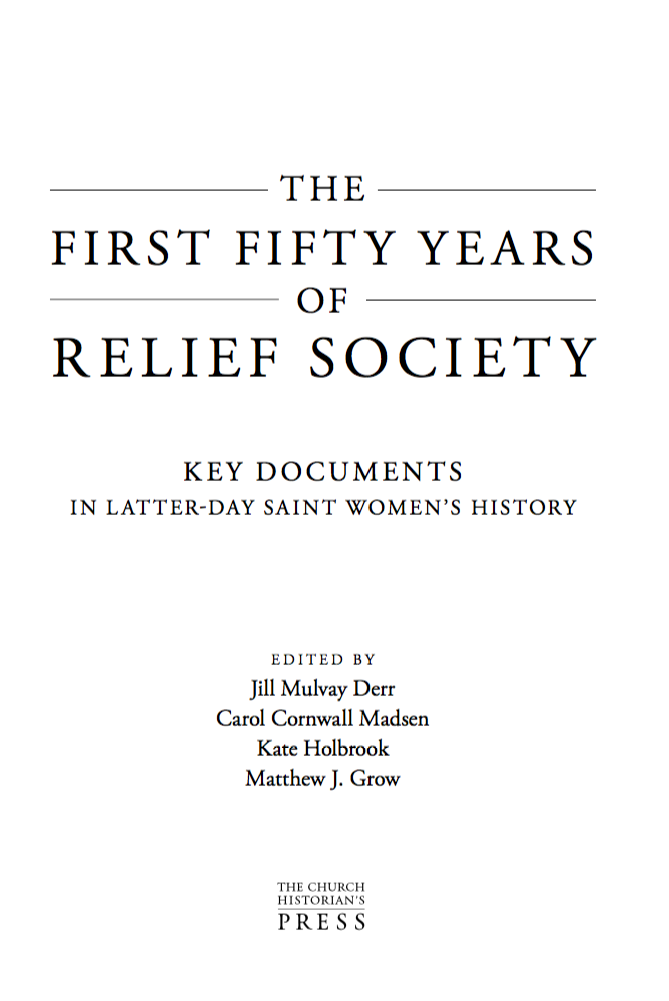Copyright 2016 by Intellectual Reserve, Inc. All rights reserved.
The Church Historians Press is an imprint of the Church History Department of The Church of Jesus Christ of Latter-day Saints, Salt Lake City, Utah, and a trademark of Intellectual Reserve, Inc.
churchhistorianspress.org
Art direction: Richard Erickson.
Cover and jacket design: Riley M. Lorimer and Sheryl Dickert Smith. Interior design: Richard Erickson.
Typography: Riley M. Lorimer.
E-book: Ben Ellis Godfrey.
Jacket image: Provo, Utah, Fourth Ward Relief Society Presidency. Left to right: Mary M. Boyden, Margaret Watson, Delia Booth, Sara Eggertson Cluff. Photograph by Conkling Photography, Provo, Utah, ca. 1892. Church History Library, Salt Lake City.
Library of Congress Cataloging-in-Publication Data
The first fifty years of Relief Society: key documents in Latter-day Saint womens history /
edited by Jill Mulvay Derr, Carol Cornwall Madsen, Kate Holbrook, [and] Matthew J. Grow.
Includes bibliographical references and index.
ISBN 978-1-62972-150-7 (hardbound : alk. paper)
1. Relief Society (Church of Jesus Christ of Latter-day Saints)History19th century.
2. Mormon womenHistory19th century. I. Derr, Jill Mulvay, editor. II. Madsen, Carol Cornwall, 1930 editor.
III. Holbrook, Kate, editor. IV. Grow, Matthew J., editor.
BX8643.R38F57 2016 267.449332dc23 2015032416
Printed in the United States of America on acid-free paper.
10 9 8 7 6 5 4 3 2 1
Contents
The First Fifty Years of Relief Society
Reference Material
Introduction
As Latter-day Saints prepared to leave Nauvoo, Illinois, in the early months of 1846 for their long trek to the West, clerks packed into one small box and one large box stacks of records, including Joseph Smiths journals and history, as well as minutes, ledgers, and letters from the Saints sojourns in New York, Ohio, Missouri, and Illinois. These early accounts of the churchs beginnings accompanied the Saints to their new home in the Mountain West and served as the foundation for the enduring community they established there. At least one important record made the journey outside the inventoried boxes. A Book of Records. Containing the proceedings of The Female Relief Society of Nauvoo traveled west with its primary author, Relief Society secretary Eliza R. Snow. This treasured volume was crucial to the reconstitution and expansion of the Relief Society, the organization through which Latter-day Saint women ministered, in the last half of the nineteenth century. It is the foundational document in this collection.
Nineteenth-century Latter-day Saint women understood the significance of their records. Their individual and collective documents evidence a deep faith in the religion that emerged from the visions and revelations of Joseph Smith: The Church of Jesus Christ of Latter-day Saints, formally established in 1830. Its members believed it to be the kingdom of God on earth, and they regarded its doctrine, ordinances, and authority structure as divinely revealed and essential to their spiritual salvation. Church membership was at once intensely personal and essentially communal, a system of belief that affected an individuals entire way of life. This volume examines Latter-day Saint womens temporal and spiritual activities, demonstrating how the church served as the reference point for their marriage and family life, church service, and civic engagement. The private and corporate records created by women illuminate their belief that the church both ennobled and challenged women, and their conviction that the church enriched their own relationship to the divine.
Church members believed that records established precedent and helped nourish faith. Both the Bible and the Book of Mormon, one of the Latter-day Saints unique books of scripture, underscored the importance of keeping, preserving, and studying records. Before the formation of the Relief Society in 1842, the churchs institutional records were largely created by and focused on the activities of the men who led the church. For example, Joseph Smiths revelations were recorded, edited, and published primarily through the efforts of his male counselors, scribes, and clerks; and official church minute books recorded the deliberations of the all-male presidencies, quorums, and councils that governed the church generally and locally. Latter-day Saint women had occasionally helped create official church records. Emma Smith, Josephs wife, served as a Book of Mormon scribe and helped preserve the manuscript of the book as well as other important records. and hundreds of Latter-day Saint women wrote letters, diaries, and reminiscences.
The establishment of the Female Relief Society of Nauvoo in March 1842 and the appointment of Eliza R. Snow as the organizations first secretary marked the beginning of institutional record keeping by and about Latter-day Saint women. The minutes Snow and other women kept of Relief Society meetings from 1842 through 1844 are the single most important document in this volume. In addition to chronicling members beliefs and contributions, the Nauvoo minutes include sermons Joseph Smith delivered during six of the nine visits he made to the society in 1842. Containing the only recorded words he directed exclusively to the women of the church, the minutes were regarded as a sacred and prophetic record that provided the authorization and pattern for womens temporal and spiritual ministry.
Willard Richards, Joseph Smiths clerk, gave Snow a book for keeping minutes of the meetings. Thereafter, she and her assistants kept a record during the two years the society functioned in Nauvoo. These minutes remained in Snows possession through her tenure as Relief Society president in Utah Territory (18801887) and then passed to her successor, Zina D. H. Young (18881901), and in turn to her successor, Bathsheba W. Smith (19011910). Not until 1911, following Bathsheba Smiths death, did the volume become part of the collection of the church historian, finally joining the historical records boxed up in Nauvoo.
This foundational record of the Female Relief Society of Nauvoo served as a constitution for the Relief Society, setting forth its purposes, structure, and procedures. In the initial organizational meeting, Joseph Smith stated that the minutes of your meetings will be precedents for you to act upon your Constitutio[n] and law.
The Nauvoo minute book also contributed to a record-keeping consciousness and became a model for local minute books in Utah. Title pages of some of the local minute books commenced in the late 1860s display format and wording copied from the title page of the Nauvoo minute book. In some instances, Snow wrote the title page or initial entries, revealing her deep commitment to maintaining the precedent established with the Nauvoo record.
The minute book also taught women the significance of their records. The seriousness with which women kept minute books underscored the sense of permanence and importance they attributed to their Relief Society work as well as the written record of it. For example, the Relief Society minutes for the Salt Lake City Seventh Ward were kept initially in the 1850s in a very long and narrow account book, which was actually a newspaper subscription book. When the Relief Society was reorganized in 1868, the local women started to keep the minutes there again, and then they obtained a new minute book. In this big, thick minute book they recopied some of the previous meetings minutes and continued to keep records of their meetings well into the 1890s. These women esteemed their Seventh Ward minutes the same way Eliza R. Snow treasured the Nauvoo Relief Society minutes. Official organizations for children and young women, which the Relief Society nurtured, also kept minute books according to the same model. The commitment of women keeping records resulted in hundreds of official Relief Society records that are now preserved in the Church History Library in Salt Lake City, Utah.

